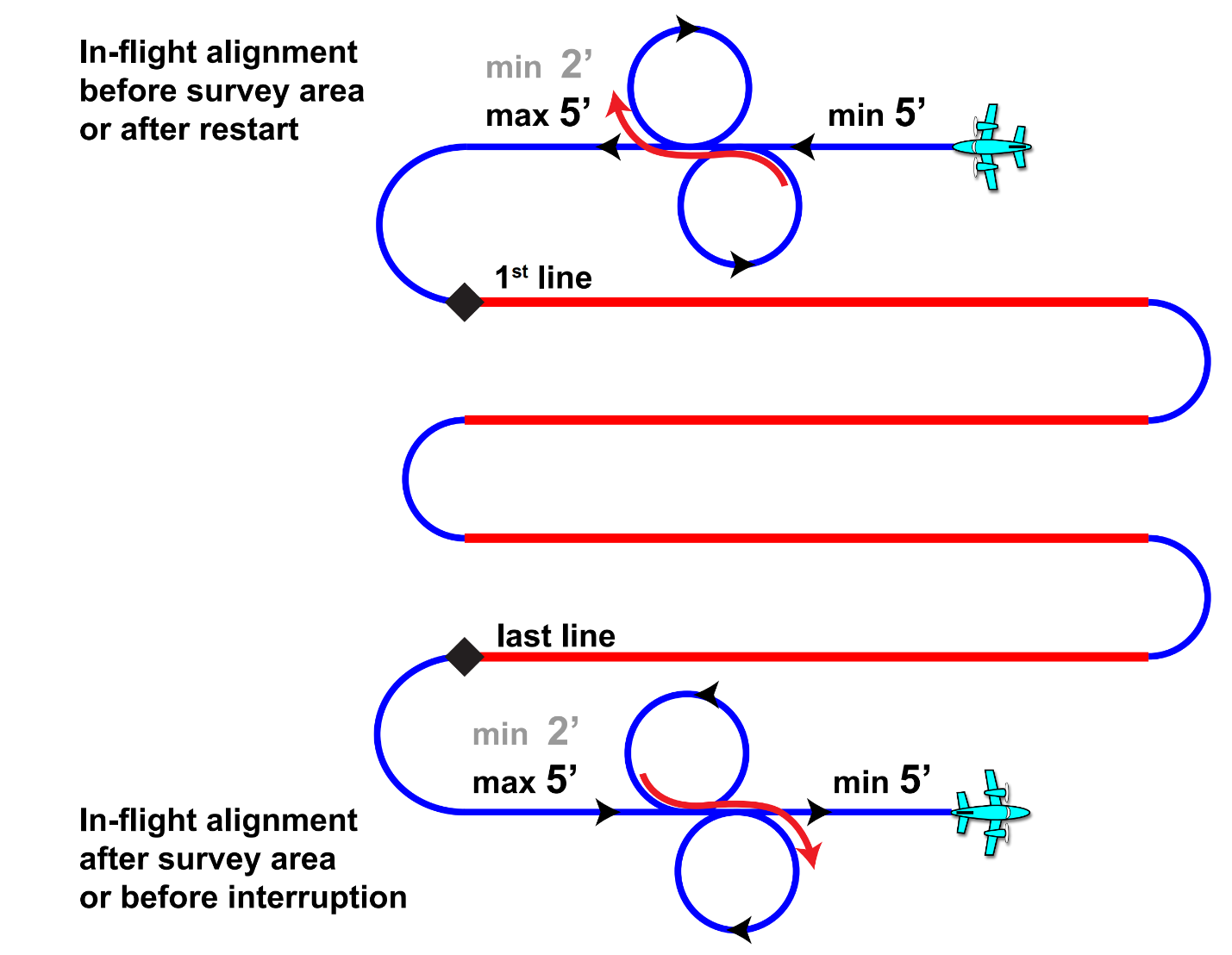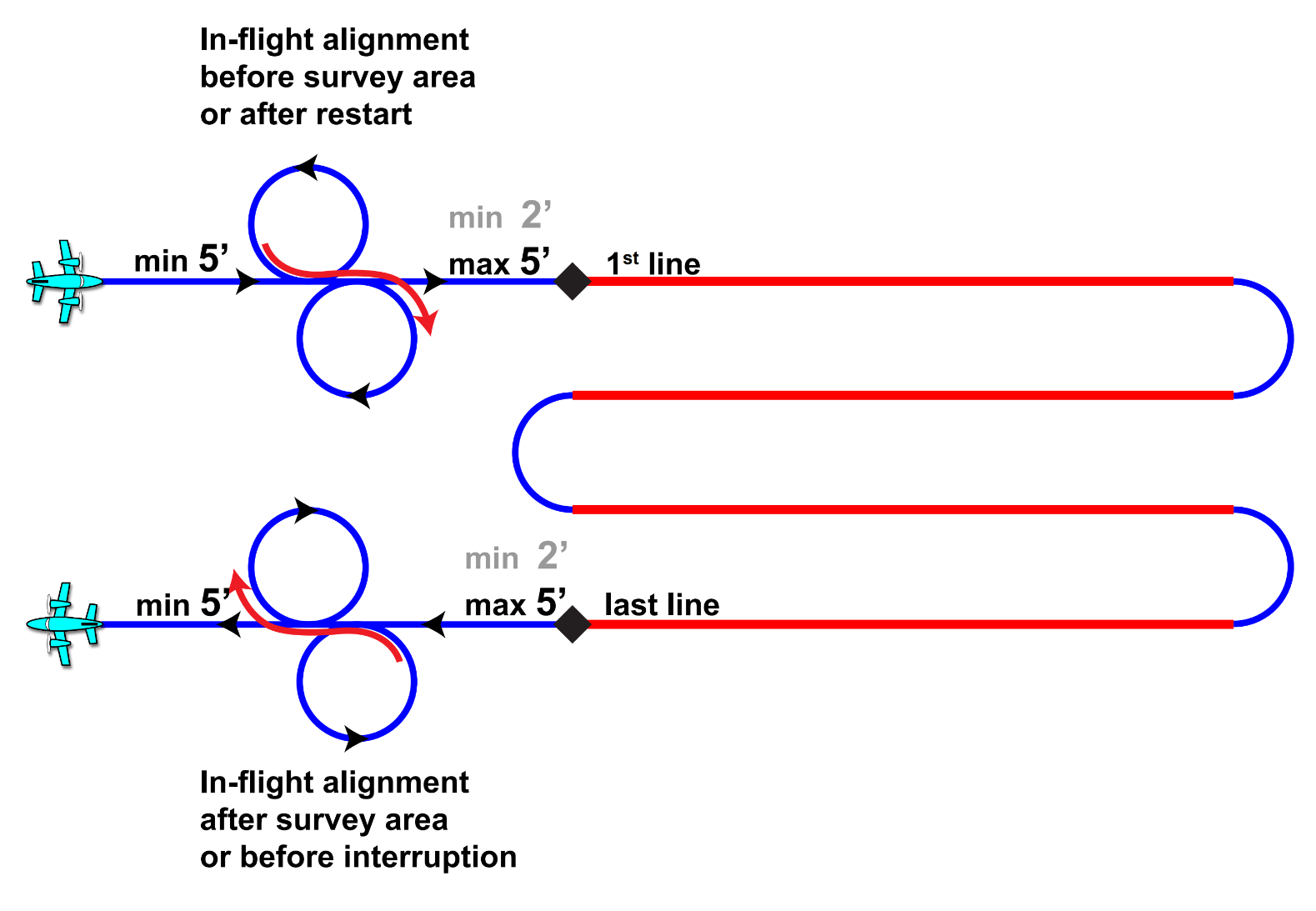Performing In-Flight Alignment
For all misalignment and project flights, it is recommended to perform a proper start and end alignment using a Figure 8 pattern as described below.
In addition to executing a proper alignment (Figure 8 ) pattern, it is advisable to turn on the system 10-15 minutes before the start alignment and to keep it on for 10-15 minutes after completing the end alignment. Base station data should be used to process the trajectory for the entire period between the recommended turn-on and turn-off times (+/- 10-15 minutes before/after start/end alignment) of the system.
A proper start and end alignment includes the following steps, which should be conducted at the same level as the project, with the pod lifter in the bottom position:
In-Flight Alignment Before Survey Area or After Restart of Execution
System Setup:
Ensure the system is in recording position. If using a Pod Lifter Heavy Load, it must be in the bottom position.
Turn on the system at least 15 minutes before approaching the project area for GNSS/IMU data recording.
Initial Flight Preparation:
Check that the aircraft is at the planned flight level of the first flight line before starting the in-flight alignment pattern .
Begin the in-flight alignment procedure approximately 10 minutes before reaching the first line.
Alignment Process:
Fly with a constant heading, velocity, and altitude for at least 5 minutes before starting the Figure 8 flight pattern.
Perform the Figure 8 flight pattern with a bank angle of less than 25°.
After completing the Figure 8 flight pattern, continue flying with a constant heading, velocity, and altitude for 2-5 minutes before starting the first flight line.
Flight Line Considerations:
If the first line is shorter than 15 minutes, no additional turn is needed before starting the flight line.
If the first line is longer than 15 minutes, perform a 90° or 180° turn before starting the flight line. This prevents unexpected IMU bias at the end of the flight line, which can negatively affect trajectory accuracy if flying straight lines longer than 20 minutes.
In-Flight Alignment After Survey Area or Before Flight Interruption
Post-Flight Line Preparation:
After completing the last flight line, maintain a constant heading, velocity, and altitude for 2-5 minutes before starting the Figure 8 flight pattern.
Flight Line Considerations:
If the last line is shorter than 15 minutes, no additional turn is needed before starting the Figure 8 flight pattern.
If the last line is longer than 15 minutes, perform a 90° or 180° turn before starting the Figure 8 flight pattern. This is necessary to prevent unexpected IMU bias at the end of the flight line, which can negatively affect trajectory accuracy for straight lines longer than 20 minutes.
Alignment Process:
Perform the Figure 8 flight pattern with a bank angle of less than 25°.
After completing the Figure 8 flight pattern, continue flying with a constant heading, velocity, and altitude for at least 5 minutes.
System Shutdown Preparation:
Keep the system running for an additional 10-15 minutes after completing the alignment process, ensuring it remains in recording position. If using a Pod Lifter Heavy Load, it must be in the bottom position.
After the 10-15 minutes of GNSS/IMU data recording, the system can be prepared for shutdown and landing. The Pod Lifter Heavy Load can then be moved to the top position.
If lines are longer then 15 minutes | If lines shorter then 15 minutes |
|---|---|

| 
|
General Alignment Guidelines:
Alignments must be performed at the same level as the flight lines. If a change in flight levels is necessary and the distance between levels exceeds 500 meters, a complete alignment must be performed for each level.
Base station data must be available for the entire duration of the start-alignment procedure, data recording, and end-alignment procedure.
The system must be in recording position; if using a Pod Lifter Heavy Load, it must be in the bottom position.
The maximum base length between the base station and project lines should be within 50 km, and for misalignment flights, it should be within 30 km.
The maximum flying time of a line, regardless of whether data is collected, must not exceed 20 minutes. Beyond this duration, IMU bias may negatively impact trajectory quality.
Start-Alignment Procedure:
GNSS/IMU data Recording:
Begin with a 10-15 minute span recording before the start-alignment procedure.
Initial Flight:
Fly for 5 minutes with a constant heading, level, and speed at the level of the first line.
Figure 8 Flight Pattern:
Perform a Figure 8 flight pattern.
Post-Figure 8 Flight Pattern:
Continue flying with a constant heading, level, and speed for an additional 2-5 minutes.
If the first project line is longer than 15 minutes, perform a turn before proceeding.
Pre-Flight Line Preparation:
Ensure the system is ready 10-15 minutes before starting the first line.
End-Alignment Procedure:
Post-Flight Line Turn:
If the last project line is longer than 15 minutes, perform a turn.
Initial Flight:
Fly for 5 minutes with a constant heading, level, and speed at the level of the last line.
Figure 8 Flight Pattern:
Perform a Figure 8 flight pattern.
Post-Figure 8 Flight Pattern:
Continue flying with a constant heading, level, and speed for an additional 2-5 minutes.
GNSS/IMU data Recording:
Conduct an additional 10-15 minute span recording after the end-alignment procedure.